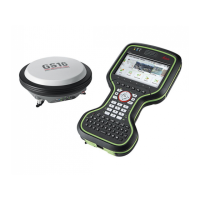GS14/GS16, Technical Data
50
6.1.3 Accuracy
Accuracy is dependent upon various factors including the number of satellites tracked,
constellation geometry, observation time, ephemeris accuracy, ionospheric distur-
bance, multipath and resolved ambiguities.
The following accuracies, given as root mean square, are based on measurements
processed using Infinity and on real-time measurements.
The use of multiple GNSS systems can increase accuracy by up to 30% relative to GPS
only.
Differential code The baseline precision of a differential code solution for static and kinematic surveys
is 25 cm.
Differential phase
in post-processing
Differential phase
in real-time
6.1.4 Technical Data
Dimensions
Weight Instrument weight without battery, SIM card and SD card:
Recording Data (Leica GNSS raw data and RINEX data) can be recorded on the SD card.
1 GB is sufficient for over 1 year of raw data logging based on logging every 15 s from
an average of 15 satellites.
Power
Type Horizontal Vertical
Static and rapid static 3 mm + 0.5 ppm 5 mm + 0.5 ppm
Kinematic 8 mm + 1 ppm 15 mm + 1 ppm
Static with long observations 3 mm + 0.1 ppm 3.5 mm + 0.4 ppm
Type Horizontal Vertical
Single Baseline (<30 km) 8 mm + 1 ppm 15 mm + 1 ppm
Network RTK 8 mm + 0.5 ppm 15 mm + 0.5 ppm
Height: 0.090 m
Diameter: 0.190 m
Type Weight [kg]/[lbs]
GS14/GS16 0.93/2.04
Power consumption: GS14, radio excluded: 2.6 W typically, 220 mA
(with external battery), 350 mA (with internal
battery)
GS16, radio excluded: 3.1 W typically, 260 mA
(with external battery), 420 mA (with internal
battery)
External supply voltage: Nominal 12 V DC ( , GEV71 car battery cable to
a 12 V car battery), voltage range
10.5V-28VDC

